Employee Motivation: Perceptions, Attitudes, and Motivation Theories
VerifiedAdded on 2022/08/15
|13
|3123
|28
Report
AI Summary
This report examines the case of Mr. Simon, a long-term line manager in a retail organization who is experiencing disillusionment after being repeatedly passed over for promotion. The report analyzes Mr. Simon's situation by exploring the interplay of perceptions, attitudes, and motivation theories, including Maslow's Hierarchy of Needs, Herzberg's Two-Factor Theory, and McClelland's Need Achievement Theory. It investigates how these theories can be applied to understand and address the factors contributing to Mr. Simon's demotivation, such as unmet esteem needs and the impact of recognition. Furthermore, the report discusses the practical applicability of these motivation theories for managers and leaders, highlighting the importance of clear expectations, adequate resources, and employee involvement. The role of teamwork in fostering learning, creativity, and trust is also examined, along with its potential to mitigate workplace conflicts and promote a sense of ownership. The report concludes by suggesting positive measures that can be implemented to re-motivate Mr. Simon and retain his valuable skills and abilities within the organization.
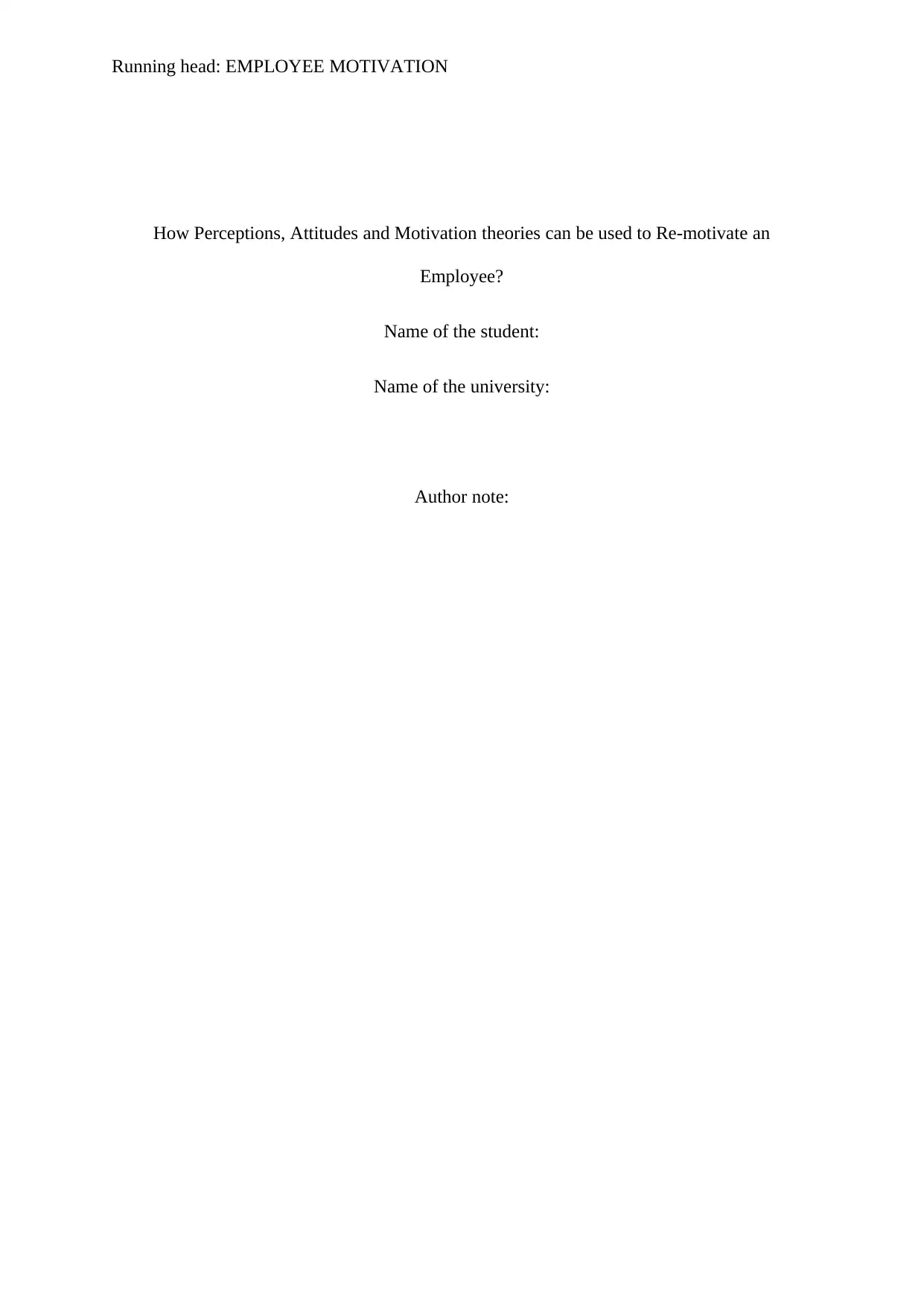
Running head: EMPLOYEE MOTIVATION
How Perceptions, Attitudes and Motivation theories can be used to Re-motivate an
Employee?
Name of the student:
Name of the university:
Author note:
How Perceptions, Attitudes and Motivation theories can be used to Re-motivate an
Employee?
Name of the student:
Name of the university:
Author note:
Paraphrase This Document
Need a fresh take? Get an instant paraphrase of this document with our AI Paraphraser
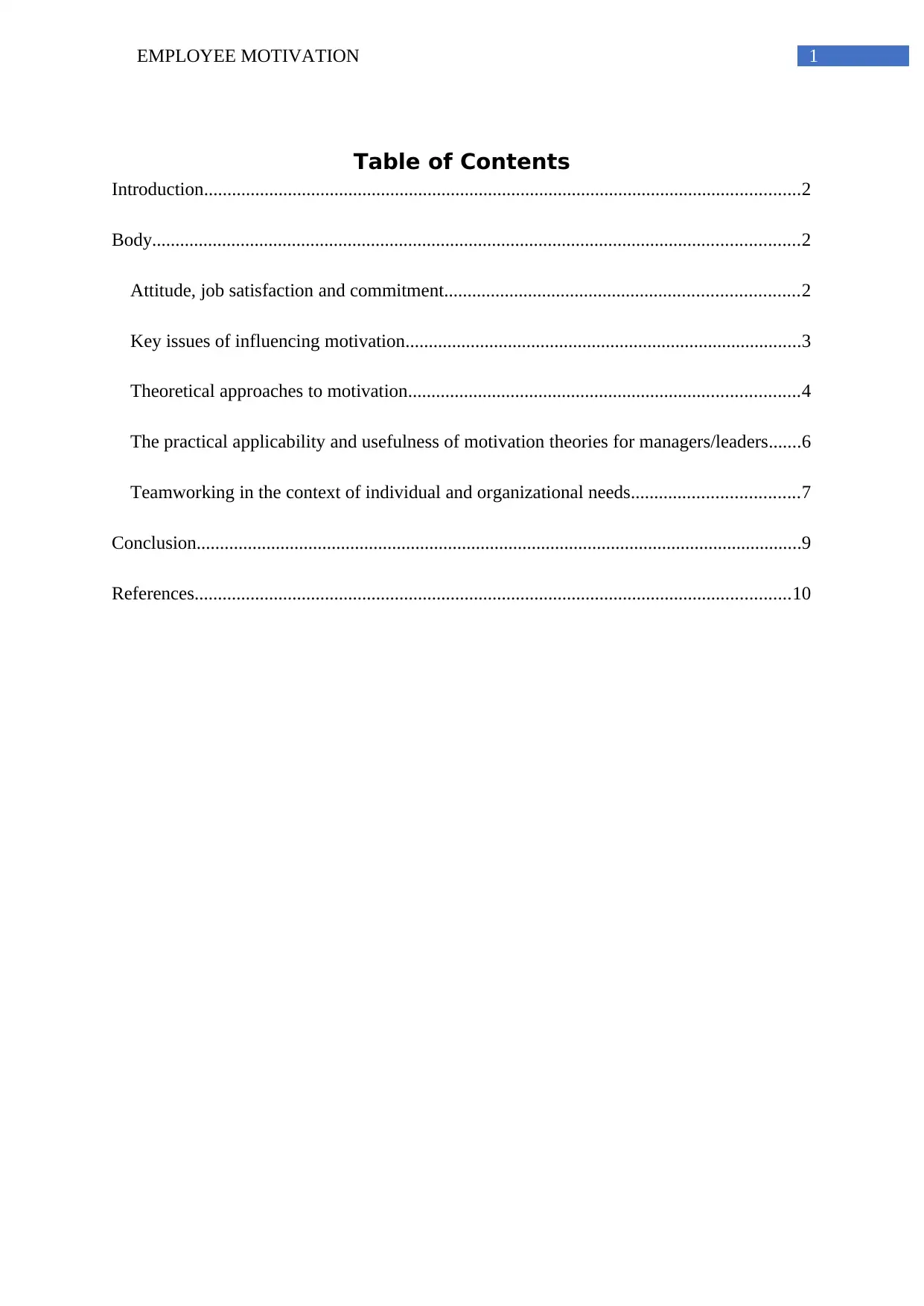
1EMPLOYEE MOTIVATION
Table of Contents
Introduction................................................................................................................................2
Body...........................................................................................................................................2
Attitude, job satisfaction and commitment............................................................................2
Key issues of influencing motivation.....................................................................................3
Theoretical approaches to motivation....................................................................................4
The practical applicability and usefulness of motivation theories for managers/leaders.......6
Teamworking in the context of individual and organizational needs....................................7
Conclusion..................................................................................................................................9
References................................................................................................................................10
Table of Contents
Introduction................................................................................................................................2
Body...........................................................................................................................................2
Attitude, job satisfaction and commitment............................................................................2
Key issues of influencing motivation.....................................................................................3
Theoretical approaches to motivation....................................................................................4
The practical applicability and usefulness of motivation theories for managers/leaders.......6
Teamworking in the context of individual and organizational needs....................................7
Conclusion..................................................................................................................................9
References................................................................................................................................10
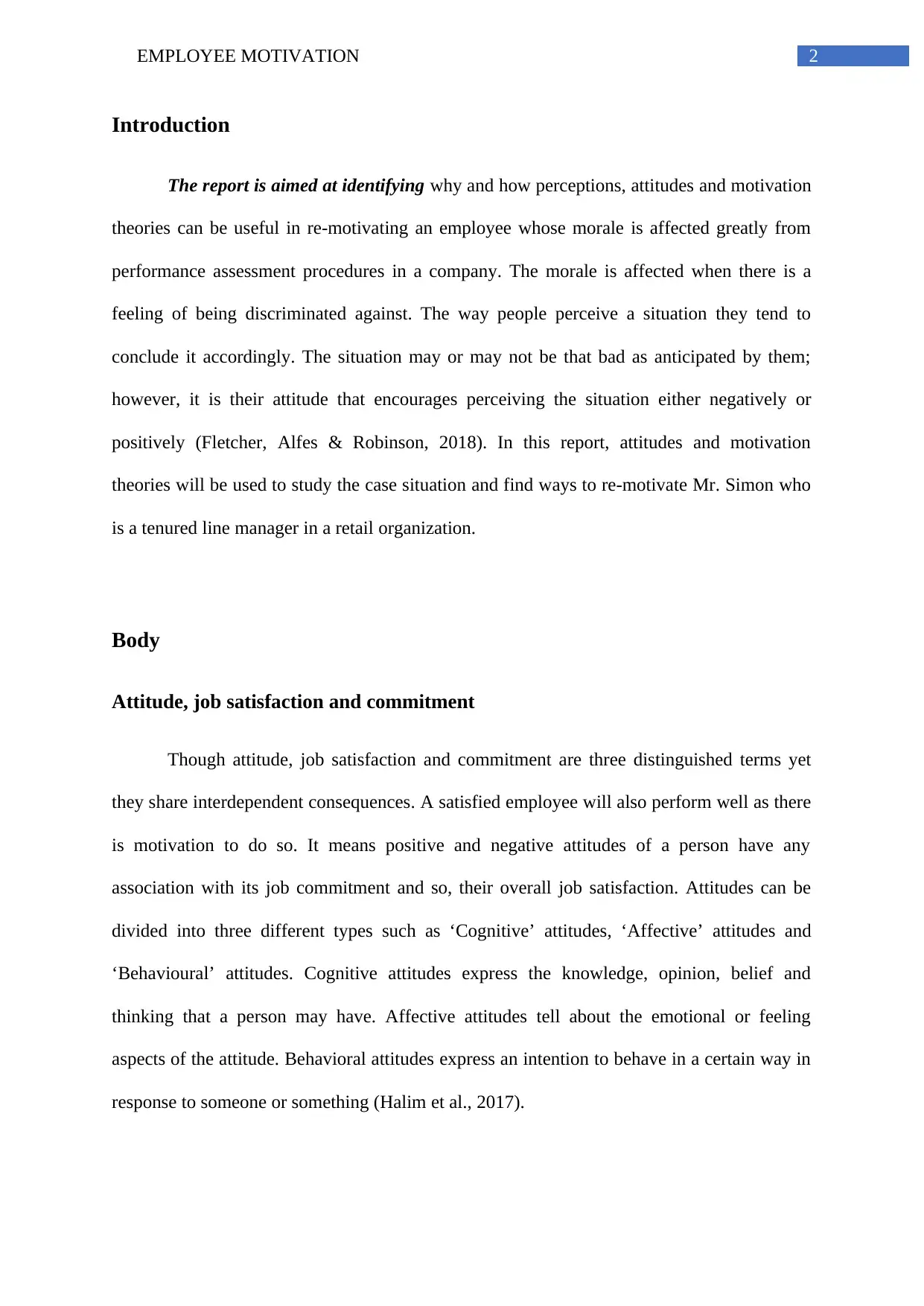
2EMPLOYEE MOTIVATION
Introduction
The report is aimed at identifying why and how perceptions, attitudes and motivation
theories can be useful in re-motivating an employee whose morale is affected greatly from
performance assessment procedures in a company. The morale is affected when there is a
feeling of being discriminated against. The way people perceive a situation they tend to
conclude it accordingly. The situation may or may not be that bad as anticipated by them;
however, it is their attitude that encourages perceiving the situation either negatively or
positively (Fletcher, Alfes & Robinson, 2018). In this report, attitudes and motivation
theories will be used to study the case situation and find ways to re-motivate Mr. Simon who
is a tenured line manager in a retail organization.
Body
Attitude, job satisfaction and commitment
Though attitude, job satisfaction and commitment are three distinguished terms yet
they share interdependent consequences. A satisfied employee will also perform well as there
is motivation to do so. It means positive and negative attitudes of a person have any
association with its job commitment and so, their overall job satisfaction. Attitudes can be
divided into three different types such as ‘Cognitive’ attitudes, ‘Affective’ attitudes and
‘Behavioural’ attitudes. Cognitive attitudes express the knowledge, opinion, belief and
thinking that a person may have. Affective attitudes tell about the emotional or feeling
aspects of the attitude. Behavioral attitudes express an intention to behave in a certain way in
response to someone or something (Halim et al., 2017).
Introduction
The report is aimed at identifying why and how perceptions, attitudes and motivation
theories can be useful in re-motivating an employee whose morale is affected greatly from
performance assessment procedures in a company. The morale is affected when there is a
feeling of being discriminated against. The way people perceive a situation they tend to
conclude it accordingly. The situation may or may not be that bad as anticipated by them;
however, it is their attitude that encourages perceiving the situation either negatively or
positively (Fletcher, Alfes & Robinson, 2018). In this report, attitudes and motivation
theories will be used to study the case situation and find ways to re-motivate Mr. Simon who
is a tenured line manager in a retail organization.
Body
Attitude, job satisfaction and commitment
Though attitude, job satisfaction and commitment are three distinguished terms yet
they share interdependent consequences. A satisfied employee will also perform well as there
is motivation to do so. It means positive and negative attitudes of a person have any
association with its job commitment and so, their overall job satisfaction. Attitudes can be
divided into three different types such as ‘Cognitive’ attitudes, ‘Affective’ attitudes and
‘Behavioural’ attitudes. Cognitive attitudes express the knowledge, opinion, belief and
thinking that a person may have. Affective attitudes tell about the emotional or feeling
aspects of the attitude. Behavioral attitudes express an intention to behave in a certain way in
response to someone or something (Halim et al., 2017).
⊘ This is a preview!⊘
Do you want full access?
Subscribe today to unlock all pages.

Trusted by 1+ million students worldwide
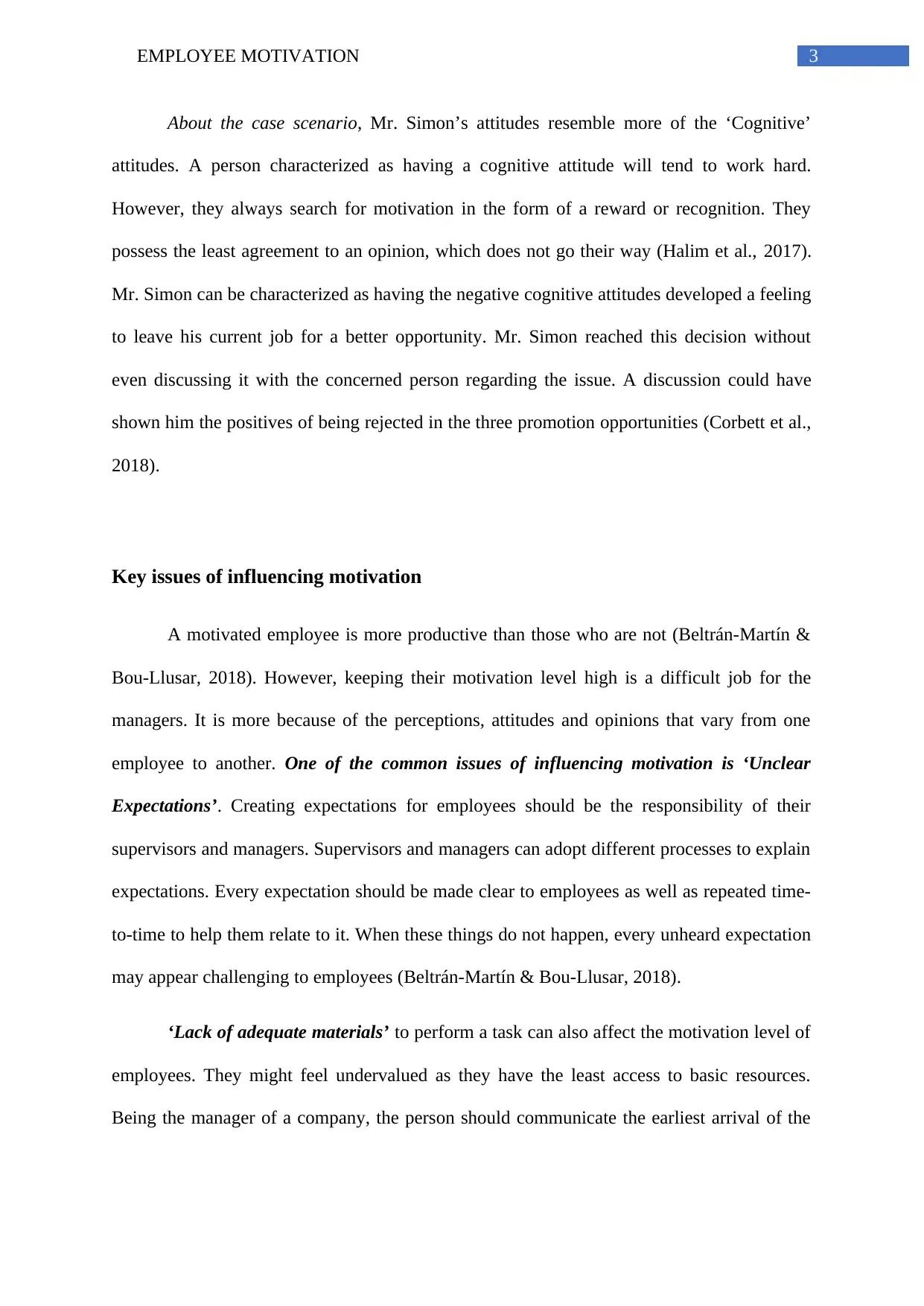
3EMPLOYEE MOTIVATION
About the case scenario, Mr. Simon’s attitudes resemble more of the ‘Cognitive’
attitudes. A person characterized as having a cognitive attitude will tend to work hard.
However, they always search for motivation in the form of a reward or recognition. They
possess the least agreement to an opinion, which does not go their way (Halim et al., 2017).
Mr. Simon can be characterized as having the negative cognitive attitudes developed a feeling
to leave his current job for a better opportunity. Mr. Simon reached this decision without
even discussing it with the concerned person regarding the issue. A discussion could have
shown him the positives of being rejected in the three promotion opportunities (Corbett et al.,
2018).
Key issues of influencing motivation
A motivated employee is more productive than those who are not (Beltrán-Martín &
Bou-Llusar, 2018). However, keeping their motivation level high is a difficult job for the
managers. It is more because of the perceptions, attitudes and opinions that vary from one
employee to another. One of the common issues of influencing motivation is ‘Unclear
Expectations’. Creating expectations for employees should be the responsibility of their
supervisors and managers. Supervisors and managers can adopt different processes to explain
expectations. Every expectation should be made clear to employees as well as repeated time-
to-time to help them relate to it. When these things do not happen, every unheard expectation
may appear challenging to employees (Beltrán-Martín & Bou-Llusar, 2018).
‘Lack of adequate materials’ to perform a task can also affect the motivation level of
employees. They might feel undervalued as they have the least access to basic resources.
Being the manager of a company, the person should communicate the earliest arrival of the
About the case scenario, Mr. Simon’s attitudes resemble more of the ‘Cognitive’
attitudes. A person characterized as having a cognitive attitude will tend to work hard.
However, they always search for motivation in the form of a reward or recognition. They
possess the least agreement to an opinion, which does not go their way (Halim et al., 2017).
Mr. Simon can be characterized as having the negative cognitive attitudes developed a feeling
to leave his current job for a better opportunity. Mr. Simon reached this decision without
even discussing it with the concerned person regarding the issue. A discussion could have
shown him the positives of being rejected in the three promotion opportunities (Corbett et al.,
2018).
Key issues of influencing motivation
A motivated employee is more productive than those who are not (Beltrán-Martín &
Bou-Llusar, 2018). However, keeping their motivation level high is a difficult job for the
managers. It is more because of the perceptions, attitudes and opinions that vary from one
employee to another. One of the common issues of influencing motivation is ‘Unclear
Expectations’. Creating expectations for employees should be the responsibility of their
supervisors and managers. Supervisors and managers can adopt different processes to explain
expectations. Every expectation should be made clear to employees as well as repeated time-
to-time to help them relate to it. When these things do not happen, every unheard expectation
may appear challenging to employees (Beltrán-Martín & Bou-Llusar, 2018).
‘Lack of adequate materials’ to perform a task can also affect the motivation level of
employees. They might feel undervalued as they have the least access to basic resources.
Being the manager of a company, the person should communicate the earliest arrival of the
Paraphrase This Document
Need a fresh take? Get an instant paraphrase of this document with our AI Paraphraser
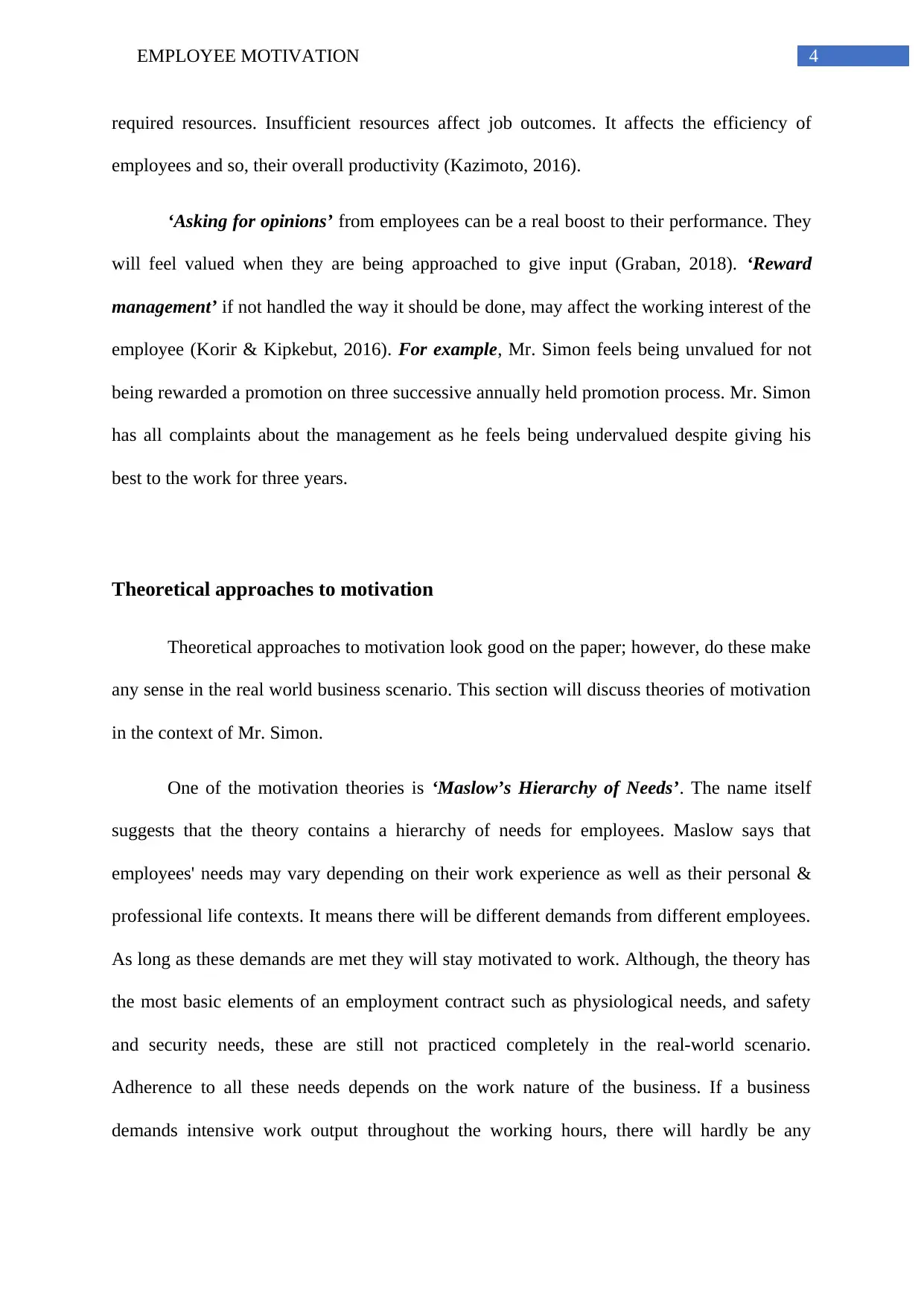
4EMPLOYEE MOTIVATION
required resources. Insufficient resources affect job outcomes. It affects the efficiency of
employees and so, their overall productivity (Kazimoto, 2016).
‘Asking for opinions’ from employees can be a real boost to their performance. They
will feel valued when they are being approached to give input (Graban, 2018). ‘Reward
management’ if not handled the way it should be done, may affect the working interest of the
employee (Korir & Kipkebut, 2016). For example, Mr. Simon feels being unvalued for not
being rewarded a promotion on three successive annually held promotion process. Mr. Simon
has all complaints about the management as he feels being undervalued despite giving his
best to the work for three years.
Theoretical approaches to motivation
Theoretical approaches to motivation look good on the paper; however, do these make
any sense in the real world business scenario. This section will discuss theories of motivation
in the context of Mr. Simon.
One of the motivation theories is ‘Maslow’s Hierarchy of Needs’. The name itself
suggests that the theory contains a hierarchy of needs for employees. Maslow says that
employees' needs may vary depending on their work experience as well as their personal &
professional life contexts. It means there will be different demands from different employees.
As long as these demands are met they will stay motivated to work. Although, the theory has
the most basic elements of an employment contract such as physiological needs, and safety
and security needs, these are still not practiced completely in the real-world scenario.
Adherence to all these needs depends on the work nature of the business. If a business
demands intensive work output throughout the working hours, there will hardly be any
required resources. Insufficient resources affect job outcomes. It affects the efficiency of
employees and so, their overall productivity (Kazimoto, 2016).
‘Asking for opinions’ from employees can be a real boost to their performance. They
will feel valued when they are being approached to give input (Graban, 2018). ‘Reward
management’ if not handled the way it should be done, may affect the working interest of the
employee (Korir & Kipkebut, 2016). For example, Mr. Simon feels being unvalued for not
being rewarded a promotion on three successive annually held promotion process. Mr. Simon
has all complaints about the management as he feels being undervalued despite giving his
best to the work for three years.
Theoretical approaches to motivation
Theoretical approaches to motivation look good on the paper; however, do these make
any sense in the real world business scenario. This section will discuss theories of motivation
in the context of Mr. Simon.
One of the motivation theories is ‘Maslow’s Hierarchy of Needs’. The name itself
suggests that the theory contains a hierarchy of needs for employees. Maslow says that
employees' needs may vary depending on their work experience as well as their personal &
professional life contexts. It means there will be different demands from different employees.
As long as these demands are met they will stay motivated to work. Although, the theory has
the most basic elements of an employment contract such as physiological needs, and safety
and security needs, these are still not practiced completely in the real-world scenario.
Adherence to all these needs depends on the work nature of the business. If a business
demands intensive work output throughout the working hours, there will hardly be any
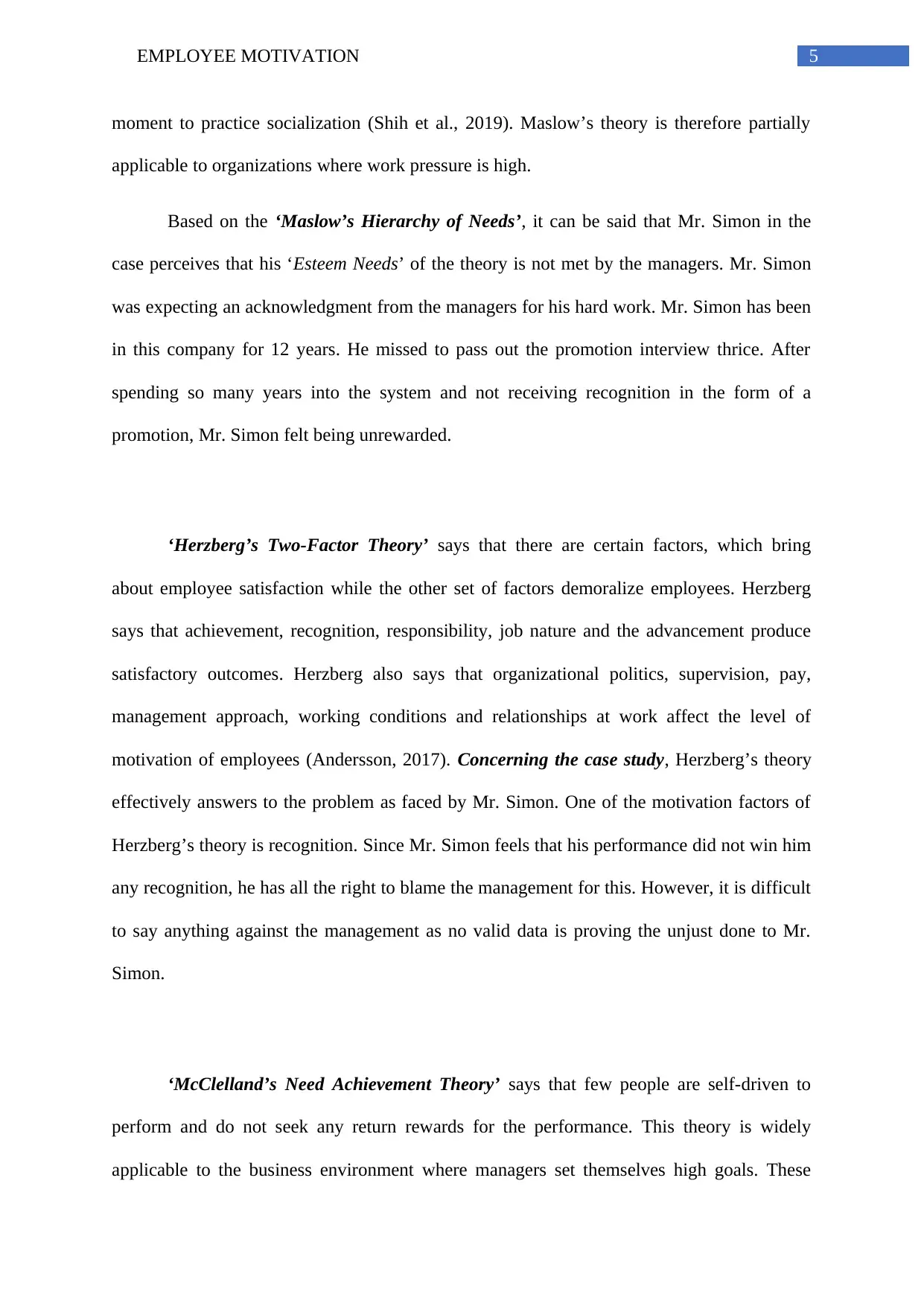
5EMPLOYEE MOTIVATION
moment to practice socialization (Shih et al., 2019). Maslow’s theory is therefore partially
applicable to organizations where work pressure is high.
Based on the ‘Maslow’s Hierarchy of Needs’, it can be said that Mr. Simon in the
case perceives that his ‘Esteem Needs’ of the theory is not met by the managers. Mr. Simon
was expecting an acknowledgment from the managers for his hard work. Mr. Simon has been
in this company for 12 years. He missed to pass out the promotion interview thrice. After
spending so many years into the system and not receiving recognition in the form of a
promotion, Mr. Simon felt being unrewarded.
‘Herzberg’s Two-Factor Theory’ says that there are certain factors, which bring
about employee satisfaction while the other set of factors demoralize employees. Herzberg
says that achievement, recognition, responsibility, job nature and the advancement produce
satisfactory outcomes. Herzberg also says that organizational politics, supervision, pay,
management approach, working conditions and relationships at work affect the level of
motivation of employees (Andersson, 2017). Concerning the case study, Herzberg’s theory
effectively answers to the problem as faced by Mr. Simon. One of the motivation factors of
Herzberg’s theory is recognition. Since Mr. Simon feels that his performance did not win him
any recognition, he has all the right to blame the management for this. However, it is difficult
to say anything against the management as no valid data is proving the unjust done to Mr.
Simon.
‘McClelland’s Need Achievement Theory’ says that few people are self-driven to
perform and do not seek any return rewards for the performance. This theory is widely
applicable to the business environment where managers set themselves high goals. These
moment to practice socialization (Shih et al., 2019). Maslow’s theory is therefore partially
applicable to organizations where work pressure is high.
Based on the ‘Maslow’s Hierarchy of Needs’, it can be said that Mr. Simon in the
case perceives that his ‘Esteem Needs’ of the theory is not met by the managers. Mr. Simon
was expecting an acknowledgment from the managers for his hard work. Mr. Simon has been
in this company for 12 years. He missed to pass out the promotion interview thrice. After
spending so many years into the system and not receiving recognition in the form of a
promotion, Mr. Simon felt being unrewarded.
‘Herzberg’s Two-Factor Theory’ says that there are certain factors, which bring
about employee satisfaction while the other set of factors demoralize employees. Herzberg
says that achievement, recognition, responsibility, job nature and the advancement produce
satisfactory outcomes. Herzberg also says that organizational politics, supervision, pay,
management approach, working conditions and relationships at work affect the level of
motivation of employees (Andersson, 2017). Concerning the case study, Herzberg’s theory
effectively answers to the problem as faced by Mr. Simon. One of the motivation factors of
Herzberg’s theory is recognition. Since Mr. Simon feels that his performance did not win him
any recognition, he has all the right to blame the management for this. However, it is difficult
to say anything against the management as no valid data is proving the unjust done to Mr.
Simon.
‘McClelland’s Need Achievement Theory’ says that few people are self-driven to
perform and do not seek any return rewards for the performance. This theory is widely
applicable to the business environment where managers set themselves high goals. These
⊘ This is a preview!⊘
Do you want full access?
Subscribe today to unlock all pages.

Trusted by 1+ million students worldwide
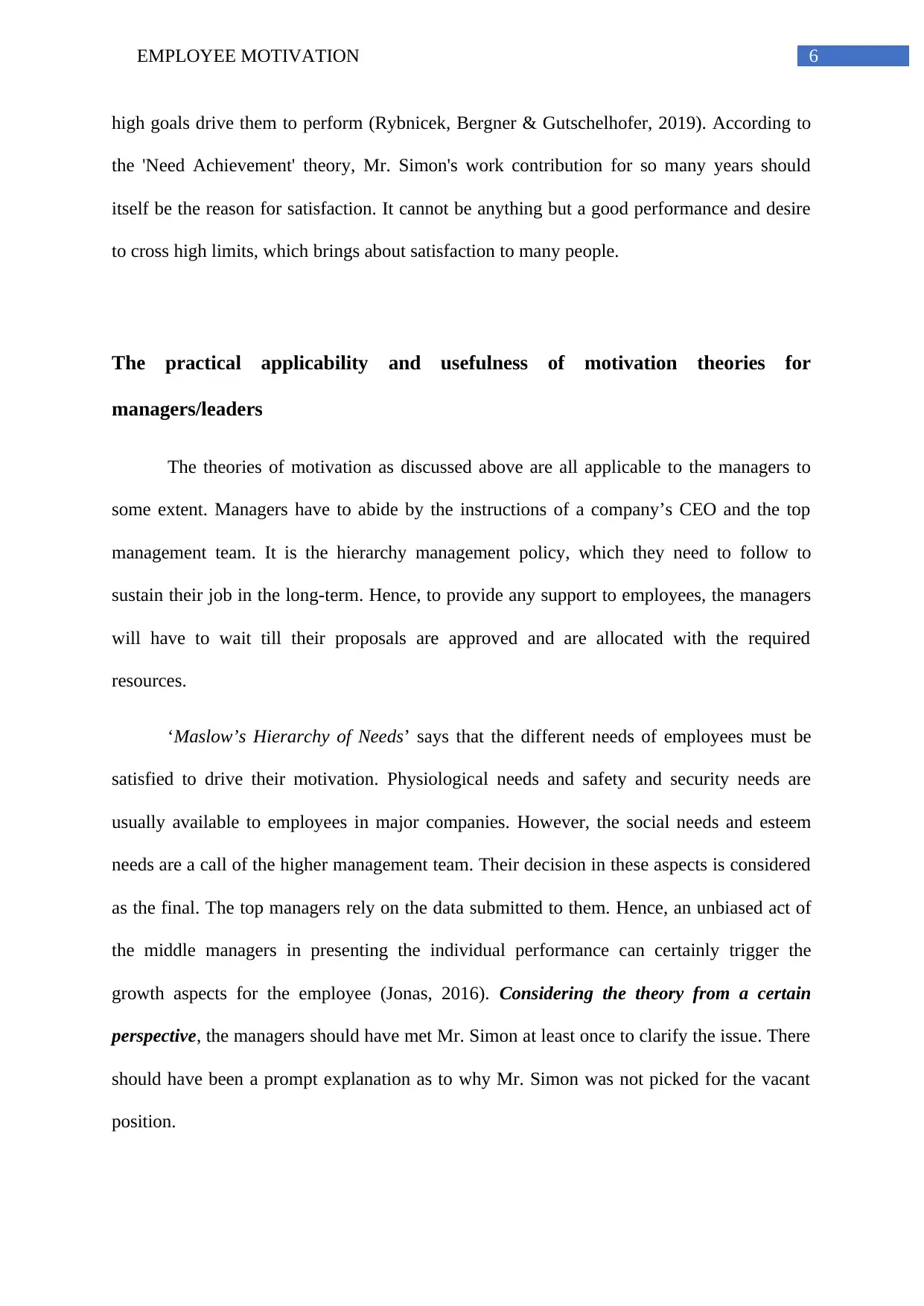
6EMPLOYEE MOTIVATION
high goals drive them to perform (Rybnicek, Bergner & Gutschelhofer, 2019). According to
the 'Need Achievement' theory, Mr. Simon's work contribution for so many years should
itself be the reason for satisfaction. It cannot be anything but a good performance and desire
to cross high limits, which brings about satisfaction to many people.
The practical applicability and usefulness of motivation theories for
managers/leaders
The theories of motivation as discussed above are all applicable to the managers to
some extent. Managers have to abide by the instructions of a company’s CEO and the top
management team. It is the hierarchy management policy, which they need to follow to
sustain their job in the long-term. Hence, to provide any support to employees, the managers
will have to wait till their proposals are approved and are allocated with the required
resources.
‘Maslow’s Hierarchy of Needs’ says that the different needs of employees must be
satisfied to drive their motivation. Physiological needs and safety and security needs are
usually available to employees in major companies. However, the social needs and esteem
needs are a call of the higher management team. Their decision in these aspects is considered
as the final. The top managers rely on the data submitted to them. Hence, an unbiased act of
the middle managers in presenting the individual performance can certainly trigger the
growth aspects for the employee (Jonas, 2016). Considering the theory from a certain
perspective, the managers should have met Mr. Simon at least once to clarify the issue. There
should have been a prompt explanation as to why Mr. Simon was not picked for the vacant
position.
high goals drive them to perform (Rybnicek, Bergner & Gutschelhofer, 2019). According to
the 'Need Achievement' theory, Mr. Simon's work contribution for so many years should
itself be the reason for satisfaction. It cannot be anything but a good performance and desire
to cross high limits, which brings about satisfaction to many people.
The practical applicability and usefulness of motivation theories for
managers/leaders
The theories of motivation as discussed above are all applicable to the managers to
some extent. Managers have to abide by the instructions of a company’s CEO and the top
management team. It is the hierarchy management policy, which they need to follow to
sustain their job in the long-term. Hence, to provide any support to employees, the managers
will have to wait till their proposals are approved and are allocated with the required
resources.
‘Maslow’s Hierarchy of Needs’ says that the different needs of employees must be
satisfied to drive their motivation. Physiological needs and safety and security needs are
usually available to employees in major companies. However, the social needs and esteem
needs are a call of the higher management team. Their decision in these aspects is considered
as the final. The top managers rely on the data submitted to them. Hence, an unbiased act of
the middle managers in presenting the individual performance can certainly trigger the
growth aspects for the employee (Jonas, 2016). Considering the theory from a certain
perspective, the managers should have met Mr. Simon at least once to clarify the issue. There
should have been a prompt explanation as to why Mr. Simon was not picked for the vacant
position.
Paraphrase This Document
Need a fresh take? Get an instant paraphrase of this document with our AI Paraphraser
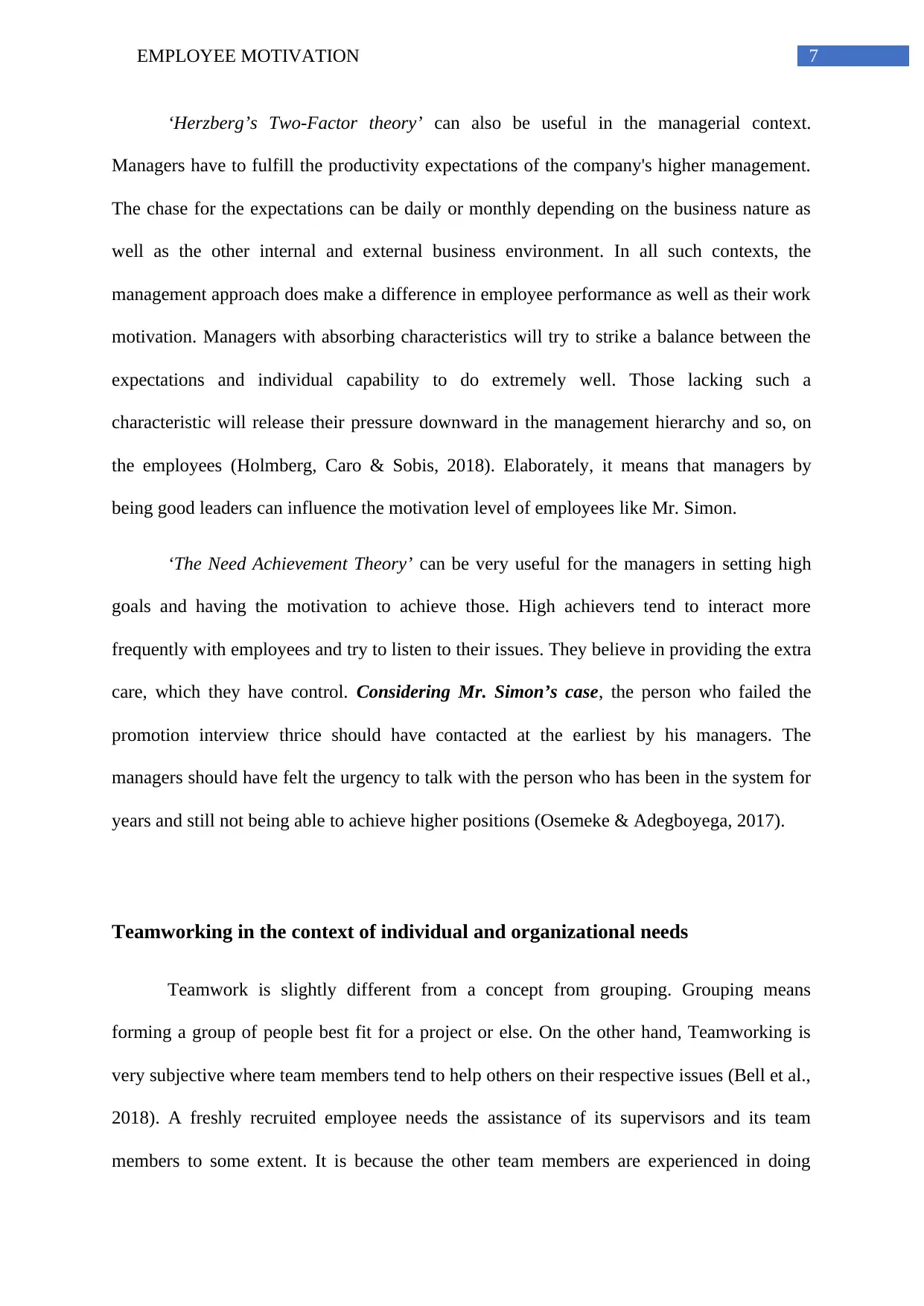
7EMPLOYEE MOTIVATION
‘Herzberg’s Two-Factor theory’ can also be useful in the managerial context.
Managers have to fulfill the productivity expectations of the company's higher management.
The chase for the expectations can be daily or monthly depending on the business nature as
well as the other internal and external business environment. In all such contexts, the
management approach does make a difference in employee performance as well as their work
motivation. Managers with absorbing characteristics will try to strike a balance between the
expectations and individual capability to do extremely well. Those lacking such a
characteristic will release their pressure downward in the management hierarchy and so, on
the employees (Holmberg, Caro & Sobis, 2018). Elaborately, it means that managers by
being good leaders can influence the motivation level of employees like Mr. Simon.
‘The Need Achievement Theory’ can be very useful for the managers in setting high
goals and having the motivation to achieve those. High achievers tend to interact more
frequently with employees and try to listen to their issues. They believe in providing the extra
care, which they have control. Considering Mr. Simon’s case, the person who failed the
promotion interview thrice should have contacted at the earliest by his managers. The
managers should have felt the urgency to talk with the person who has been in the system for
years and still not being able to achieve higher positions (Osemeke & Adegboyega, 2017).
Teamworking in the context of individual and organizational needs
Teamwork is slightly different from a concept from grouping. Grouping means
forming a group of people best fit for a project or else. On the other hand, Teamworking is
very subjective where team members tend to help others on their respective issues (Bell et al.,
2018). A freshly recruited employee needs the assistance of its supervisors and its team
members to some extent. It is because the other team members are experienced in doing
‘Herzberg’s Two-Factor theory’ can also be useful in the managerial context.
Managers have to fulfill the productivity expectations of the company's higher management.
The chase for the expectations can be daily or monthly depending on the business nature as
well as the other internal and external business environment. In all such contexts, the
management approach does make a difference in employee performance as well as their work
motivation. Managers with absorbing characteristics will try to strike a balance between the
expectations and individual capability to do extremely well. Those lacking such a
characteristic will release their pressure downward in the management hierarchy and so, on
the employees (Holmberg, Caro & Sobis, 2018). Elaborately, it means that managers by
being good leaders can influence the motivation level of employees like Mr. Simon.
‘The Need Achievement Theory’ can be very useful for the managers in setting high
goals and having the motivation to achieve those. High achievers tend to interact more
frequently with employees and try to listen to their issues. They believe in providing the extra
care, which they have control. Considering Mr. Simon’s case, the person who failed the
promotion interview thrice should have contacted at the earliest by his managers. The
managers should have felt the urgency to talk with the person who has been in the system for
years and still not being able to achieve higher positions (Osemeke & Adegboyega, 2017).
Teamworking in the context of individual and organizational needs
Teamwork is slightly different from a concept from grouping. Grouping means
forming a group of people best fit for a project or else. On the other hand, Teamworking is
very subjective where team members tend to help others on their respective issues (Bell et al.,
2018). A freshly recruited employee needs the assistance of its supervisors and its team
members to some extent. It is because the other team members are experienced in doing

8EMPLOYEE MOTIVATION
similar things that an individual was hired for. A freshly recruited employee will be more
comfortable asking a query from one of its experienced team members compared to the team
leads. Nevertheless, there are ample benefits of Teamworking both for an individual as well
as the organization.
Teamwork fosters learning and creativity. Creativity happens when individuals work
together on a project. The different thoughts that the individuals come with can be more or
less the unheard facts for many. It is how individuals get to learn new things and shape their
professional careers. Teamwork can be a good process to build trust among the team
members. When there is trust there will be knowledge flow as well between the team
members. Instead of keeping it secret they will share new ideas and pass on to their
colleagues. A flow of knowledge between the team members is essentially the essence of a
productive team (Chuang, Jackson & Jiang, 2016). Had there been moral support to Mr.
Simon from any of his team members, he would not have thought of looking for a new
opportunity. Instead, Mr. Simon would have looked to his weak zones and repairing it as
well.
Teamwork can be used as a solution to fight against workplace conflicts, a major
management issue for a company. Teamwork fosters knowledge flow from one member to
another. It does not just help in solving a problem but also increases the overall team
productivity. Teamwork promotes a sense of ownership in the members (Lindsjørn et al.,
2016). Companies having such people would face fewer issues than those faced by the
company where Mr. Simon worked.
Conclusion
similar things that an individual was hired for. A freshly recruited employee will be more
comfortable asking a query from one of its experienced team members compared to the team
leads. Nevertheless, there are ample benefits of Teamworking both for an individual as well
as the organization.
Teamwork fosters learning and creativity. Creativity happens when individuals work
together on a project. The different thoughts that the individuals come with can be more or
less the unheard facts for many. It is how individuals get to learn new things and shape their
professional careers. Teamwork can be a good process to build trust among the team
members. When there is trust there will be knowledge flow as well between the team
members. Instead of keeping it secret they will share new ideas and pass on to their
colleagues. A flow of knowledge between the team members is essentially the essence of a
productive team (Chuang, Jackson & Jiang, 2016). Had there been moral support to Mr.
Simon from any of his team members, he would not have thought of looking for a new
opportunity. Instead, Mr. Simon would have looked to his weak zones and repairing it as
well.
Teamwork can be used as a solution to fight against workplace conflicts, a major
management issue for a company. Teamwork fosters knowledge flow from one member to
another. It does not just help in solving a problem but also increases the overall team
productivity. Teamwork promotes a sense of ownership in the members (Lindsjørn et al.,
2016). Companies having such people would face fewer issues than those faced by the
company where Mr. Simon worked.
Conclusion
⊘ This is a preview!⊘
Do you want full access?
Subscribe today to unlock all pages.

Trusted by 1+ million students worldwide
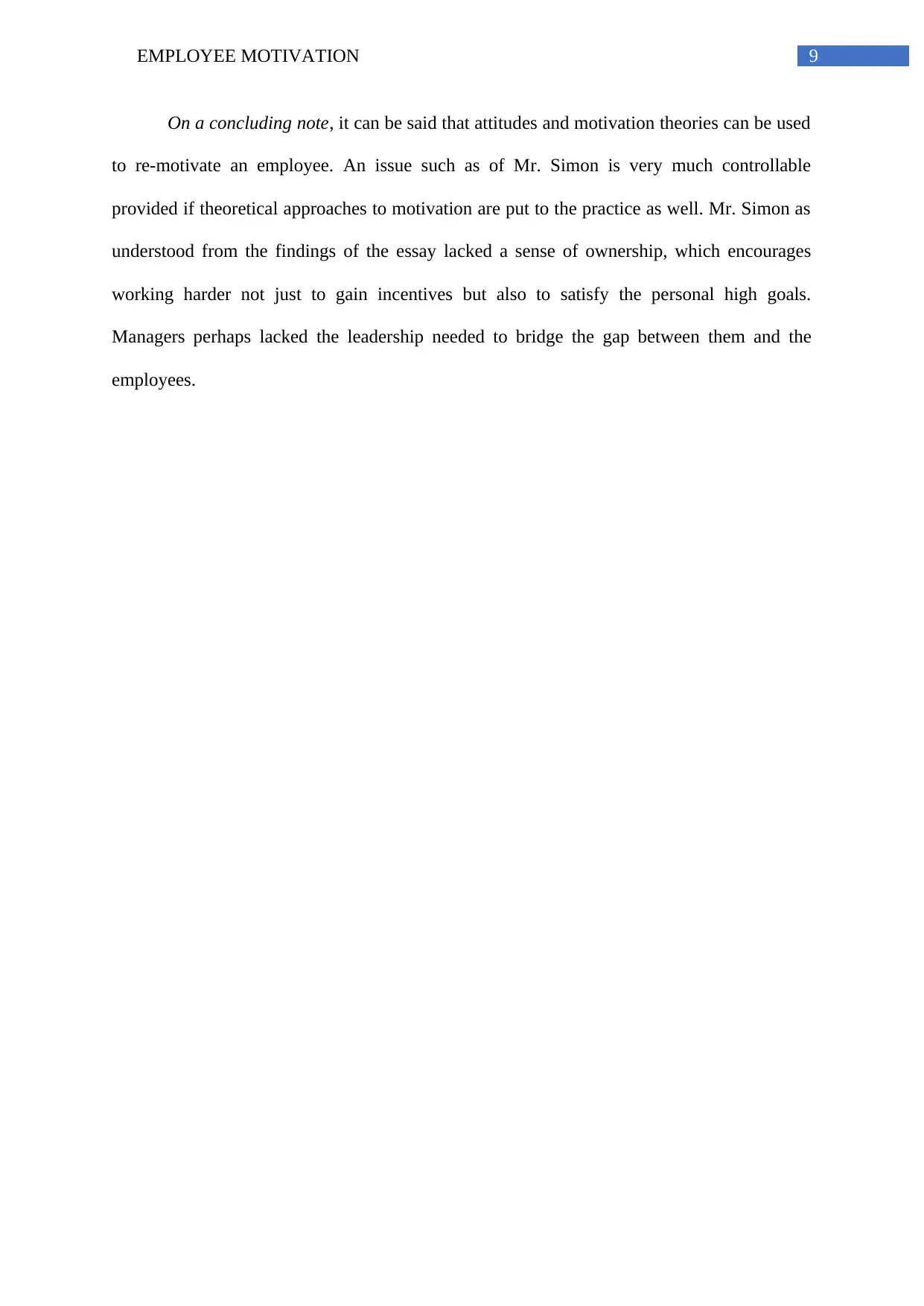
9EMPLOYEE MOTIVATION
On a concluding note, it can be said that attitudes and motivation theories can be used
to re-motivate an employee. An issue such as of Mr. Simon is very much controllable
provided if theoretical approaches to motivation are put to the practice as well. Mr. Simon as
understood from the findings of the essay lacked a sense of ownership, which encourages
working harder not just to gain incentives but also to satisfy the personal high goals.
Managers perhaps lacked the leadership needed to bridge the gap between them and the
employees.
On a concluding note, it can be said that attitudes and motivation theories can be used
to re-motivate an employee. An issue such as of Mr. Simon is very much controllable
provided if theoretical approaches to motivation are put to the practice as well. Mr. Simon as
understood from the findings of the essay lacked a sense of ownership, which encourages
working harder not just to gain incentives but also to satisfy the personal high goals.
Managers perhaps lacked the leadership needed to bridge the gap between them and the
employees.
Paraphrase This Document
Need a fresh take? Get an instant paraphrase of this document with our AI Paraphraser
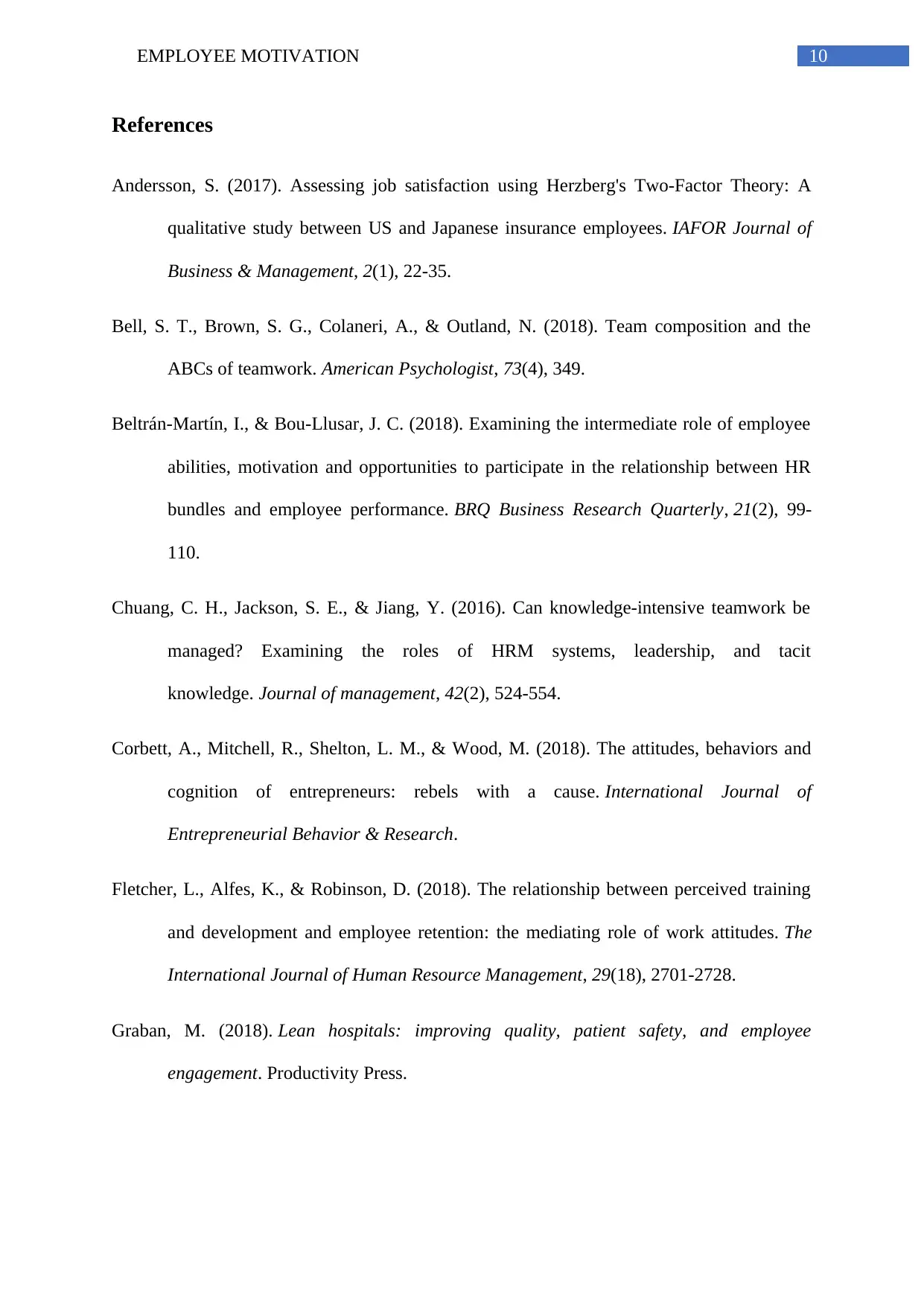
10EMPLOYEE MOTIVATION
References
Andersson, S. (2017). Assessing job satisfaction using Herzberg's Two-Factor Theory: A
qualitative study between US and Japanese insurance employees. IAFOR Journal of
Business & Management, 2(1), 22-35.
Bell, S. T., Brown, S. G., Colaneri, A., & Outland, N. (2018). Team composition and the
ABCs of teamwork. American Psychologist, 73(4), 349.
Beltrán-Martín, I., & Bou-Llusar, J. C. (2018). Examining the intermediate role of employee
abilities, motivation and opportunities to participate in the relationship between HR
bundles and employee performance. BRQ Business Research Quarterly, 21(2), 99-
110.
Chuang, C. H., Jackson, S. E., & Jiang, Y. (2016). Can knowledge-intensive teamwork be
managed? Examining the roles of HRM systems, leadership, and tacit
knowledge. Journal of management, 42(2), 524-554.
Corbett, A., Mitchell, R., Shelton, L. M., & Wood, M. (2018). The attitudes, behaviors and
cognition of entrepreneurs: rebels with a cause. International Journal of
Entrepreneurial Behavior & Research.
Fletcher, L., Alfes, K., & Robinson, D. (2018). The relationship between perceived training
and development and employee retention: the mediating role of work attitudes. The
International Journal of Human Resource Management, 29(18), 2701-2728.
Graban, M. (2018). Lean hospitals: improving quality, patient safety, and employee
engagement. Productivity Press.
References
Andersson, S. (2017). Assessing job satisfaction using Herzberg's Two-Factor Theory: A
qualitative study between US and Japanese insurance employees. IAFOR Journal of
Business & Management, 2(1), 22-35.
Bell, S. T., Brown, S. G., Colaneri, A., & Outland, N. (2018). Team composition and the
ABCs of teamwork. American Psychologist, 73(4), 349.
Beltrán-Martín, I., & Bou-Llusar, J. C. (2018). Examining the intermediate role of employee
abilities, motivation and opportunities to participate in the relationship between HR
bundles and employee performance. BRQ Business Research Quarterly, 21(2), 99-
110.
Chuang, C. H., Jackson, S. E., & Jiang, Y. (2016). Can knowledge-intensive teamwork be
managed? Examining the roles of HRM systems, leadership, and tacit
knowledge. Journal of management, 42(2), 524-554.
Corbett, A., Mitchell, R., Shelton, L. M., & Wood, M. (2018). The attitudes, behaviors and
cognition of entrepreneurs: rebels with a cause. International Journal of
Entrepreneurial Behavior & Research.
Fletcher, L., Alfes, K., & Robinson, D. (2018). The relationship between perceived training
and development and employee retention: the mediating role of work attitudes. The
International Journal of Human Resource Management, 29(18), 2701-2728.
Graban, M. (2018). Lean hospitals: improving quality, patient safety, and employee
engagement. Productivity Press.
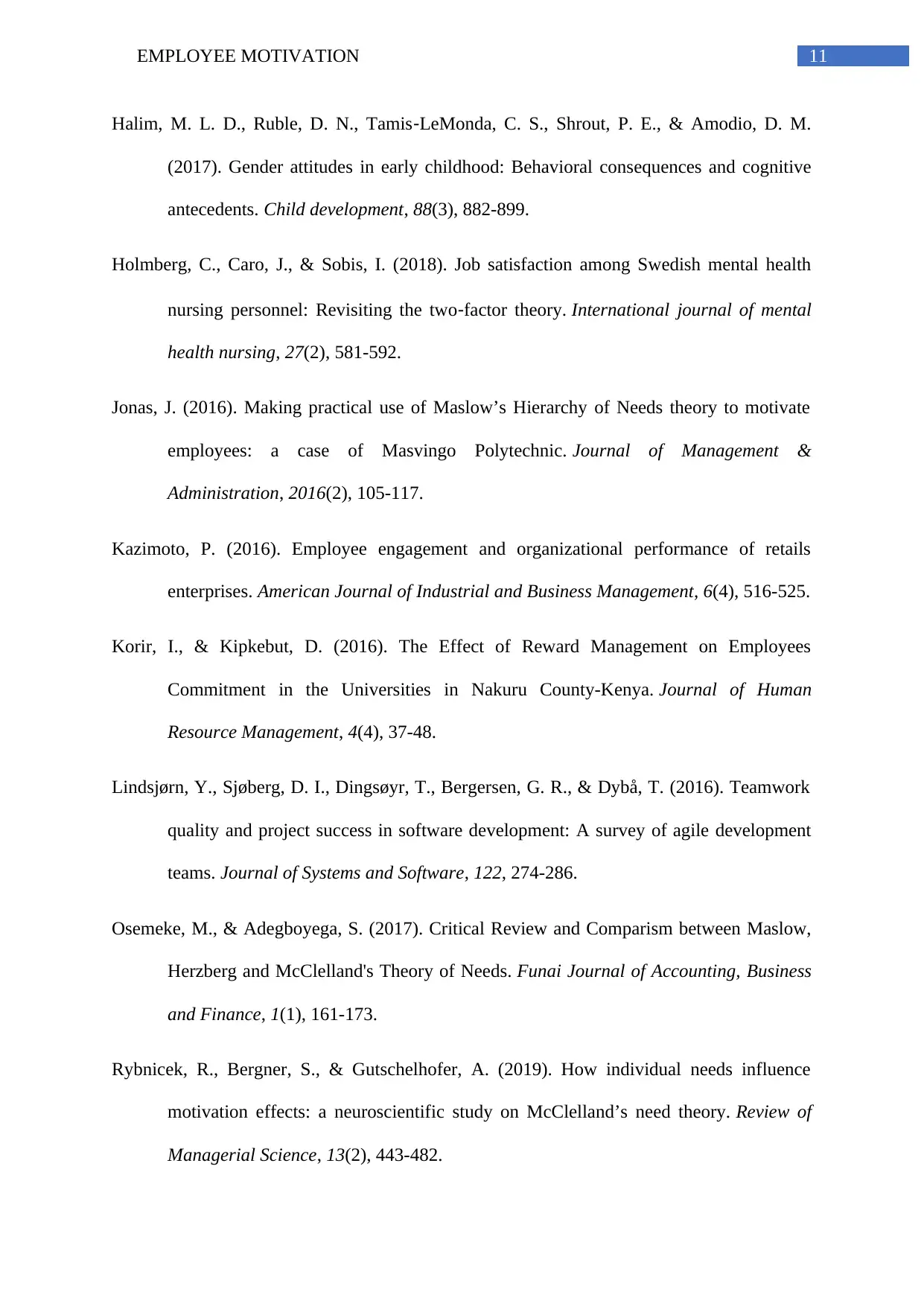
11EMPLOYEE MOTIVATION
Halim, M. L. D., Ruble, D. N., Tamis‐LeMonda, C. S., Shrout, P. E., & Amodio, D. M.
(2017). Gender attitudes in early childhood: Behavioral consequences and cognitive
antecedents. Child development, 88(3), 882-899.
Holmberg, C., Caro, J., & Sobis, I. (2018). Job satisfaction among Swedish mental health
nursing personnel: Revisiting the two‐factor theory. International journal of mental
health nursing, 27(2), 581-592.
Jonas, J. (2016). Making practical use of Maslow’s Hierarchy of Needs theory to motivate
employees: a case of Masvingo Polytechnic. Journal of Management &
Administration, 2016(2), 105-117.
Kazimoto, P. (2016). Employee engagement and organizational performance of retails
enterprises. American Journal of Industrial and Business Management, 6(4), 516-525.
Korir, I., & Kipkebut, D. (2016). The Effect of Reward Management on Employees
Commitment in the Universities in Nakuru County-Kenya. Journal of Human
Resource Management, 4(4), 37-48.
Lindsjørn, Y., Sjøberg, D. I., Dingsøyr, T., Bergersen, G. R., & Dybå, T. (2016). Teamwork
quality and project success in software development: A survey of agile development
teams. Journal of Systems and Software, 122, 274-286.
Osemeke, M., & Adegboyega, S. (2017). Critical Review and Comparism between Maslow,
Herzberg and McClelland's Theory of Needs. Funai Journal of Accounting, Business
and Finance, 1(1), 161-173.
Rybnicek, R., Bergner, S., & Gutschelhofer, A. (2019). How individual needs influence
motivation effects: a neuroscientific study on McClelland’s need theory. Review of
Managerial Science, 13(2), 443-482.
Halim, M. L. D., Ruble, D. N., Tamis‐LeMonda, C. S., Shrout, P. E., & Amodio, D. M.
(2017). Gender attitudes in early childhood: Behavioral consequences and cognitive
antecedents. Child development, 88(3), 882-899.
Holmberg, C., Caro, J., & Sobis, I. (2018). Job satisfaction among Swedish mental health
nursing personnel: Revisiting the two‐factor theory. International journal of mental
health nursing, 27(2), 581-592.
Jonas, J. (2016). Making practical use of Maslow’s Hierarchy of Needs theory to motivate
employees: a case of Masvingo Polytechnic. Journal of Management &
Administration, 2016(2), 105-117.
Kazimoto, P. (2016). Employee engagement and organizational performance of retails
enterprises. American Journal of Industrial and Business Management, 6(4), 516-525.
Korir, I., & Kipkebut, D. (2016). The Effect of Reward Management on Employees
Commitment in the Universities in Nakuru County-Kenya. Journal of Human
Resource Management, 4(4), 37-48.
Lindsjørn, Y., Sjøberg, D. I., Dingsøyr, T., Bergersen, G. R., & Dybå, T. (2016). Teamwork
quality and project success in software development: A survey of agile development
teams. Journal of Systems and Software, 122, 274-286.
Osemeke, M., & Adegboyega, S. (2017). Critical Review and Comparism between Maslow,
Herzberg and McClelland's Theory of Needs. Funai Journal of Accounting, Business
and Finance, 1(1), 161-173.
Rybnicek, R., Bergner, S., & Gutschelhofer, A. (2019). How individual needs influence
motivation effects: a neuroscientific study on McClelland’s need theory. Review of
Managerial Science, 13(2), 443-482.
⊘ This is a preview!⊘
Do you want full access?
Subscribe today to unlock all pages.

Trusted by 1+ million students worldwide
1 out of 13
Related Documents
Your All-in-One AI-Powered Toolkit for Academic Success.
+13062052269
info@desklib.com
Available 24*7 on WhatsApp / Email
![[object Object]](/_next/static/media/star-bottom.7253800d.svg)
Unlock your academic potential
Copyright © 2020–2025 A2Z Services. All Rights Reserved. Developed and managed by ZUCOL.





